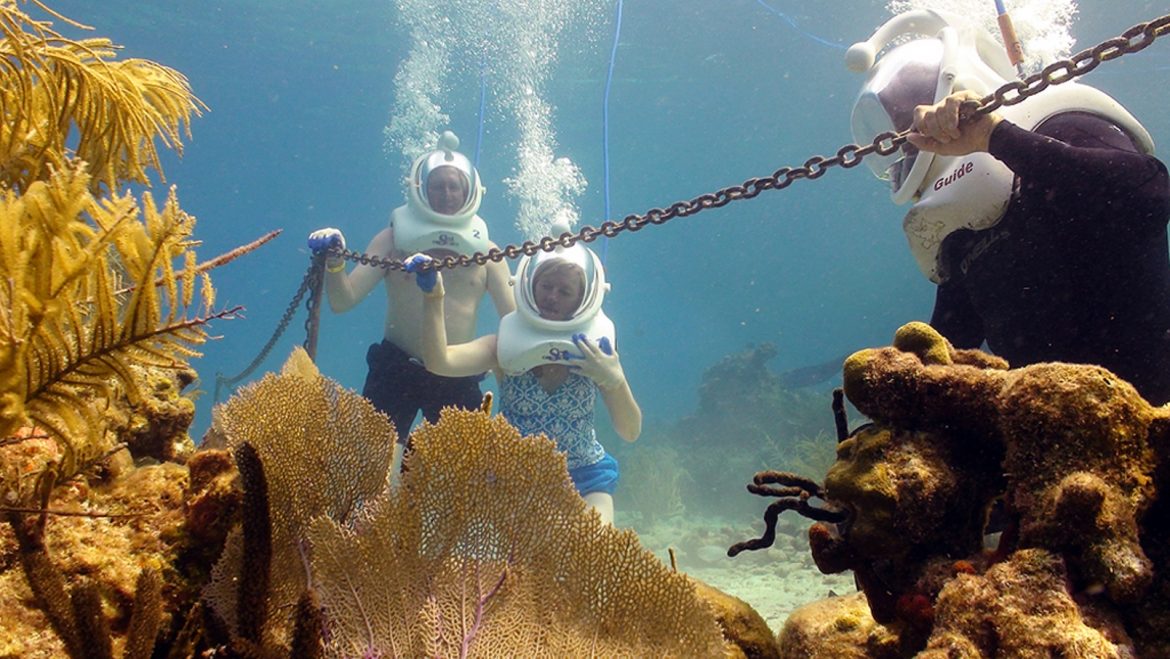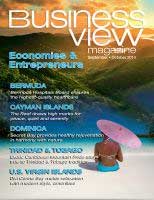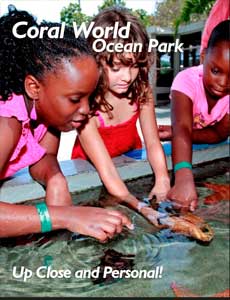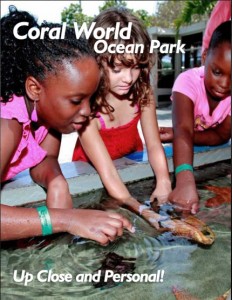Business View Caribbean interviews Lee Kellar, general curator of Coral World, as part of Best practices in St. Thomas Business.
Coral World allows world-class marine life interaction, education.
When it comes to protecting the environment, talking the talk means little if Coral World Ocean Park doesn’t also walk the walk.
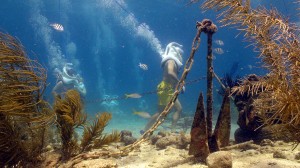 “It’s particularly critical for us because the environment is what we’re showing people, and you can’t destroy the environment that you’re trying to get the public to come and see,” said Lee Kellar, general curator of the facility on St. Thomas in the U.S. Virgin Islands.
“It’s particularly critical for us because the environment is what we’re showing people, and you can’t destroy the environment that you’re trying to get the public to come and see,” said Lee Kellar, general curator of the facility on St. Thomas in the U.S. Virgin Islands.
“There’s a negative feedback from the business model, in addition to just the strong philosophy of the people who work here. We enjoy the environment we live in and none of us have any motivation to cause damage.”
A structural step in that direction came when Coral World, in late 2012, installed a 100,000-watt solar system on the roofs of several buildings across the property.
The project served two practical purposes – one to enhance the aforementioned reputation of the facility as a sound environmental steward, and another to help defray bottom-line electricity costs. The system generates between 15 and 20 percent of the park’s overall electrical power, and the shortfall is handled by the area’s established electrical utility.
“We have a 55-cent kilowatt hour cost,” said Trudie Prior, Coral World’s general manager. “If you’re at 10 cents per kilowatt hour, it probably still doesn’t make sense to spend the money on it, but at 55 cents per kilowatt hour – given the tax incentives, it makes huge sense for us. I think our recovery on the investment is something like 2½ or three years.”
Another facet of corporate responsibility is giving back to the community.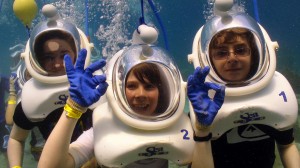
The park is an active participant in programs that make the facility available to area students for tours, and it also boasts a strong internship program that enables participants to not only learn the inner workings of the Coral World operation – but also provides the skills needed to succeed at similar organizations elsewhere in the industry.
“At our heart we are an educational organization, in addition to conservation, and that is an important role and a passion,” Kellar said. “Those are the sorts of things you have an obligation to provide, whether it’s actually formally mandated or not. It’s just the right way to operate.”
Looking toward the future, the arrival of the dolphins is circled on all Coral World calendars.
Upon final approval, the new dolphin facility will increase the park’s overall size by 50 percent and its importance is significant to the long-term health of the organization. And, Prior said, if it creates an internal drive for the people in charge of the other animal activities to raise their games, even better.
“The dolphins are going to be a very, very big thing for us,” she said. “We’re not doubling in size, but it’s a very big step and obviously we hope it’s going to result in a very big increase in the number of people who come here. After the dolphins, we’ll have to wait and see.
“The dolphins will be competing with our other activities, too, so who knows, we may come up with other things with the turtles or the sharks, too. But it’s a lot we’re biting off right now, so we want to make sure we’re doing that well before we move on to the next thing.”

Photo Credit –
Erik Miles Photography
And when it comes to Prior, if you’re looking for her between November and April, good luck.
She and her staff are at their busiest in that six-month stretch from year to year, thanks to a series of 1990s hurricanes that changed the facility from a year-round attraction to what’s become more of a spring and winter hot spot.
“We used to have an all-year season and summers were pretty good,” she said, “but the hurricanes reduced the number of summer visitors dramatically. It’s a shame because the sea is at its clearest and calmest during the summer months. How late our high season extends very much depends on when Easter falls.”
Hurricane Marilyn in 1995 dealt a particularly powerful blow to the islands – resulting in damages estimated as high as $2 billion. But in spite of the devastation, it also served as a watershed event in what’s since become a decade-plus reconstruction of a facility originally opened in the 1970s.
The Israeli company that initially built and operated the park decided not to continue after the storm and the land sat fallow for 18 months before a new ownership group, of which Prior’s husband, Neil, was the majority shareholder, joined together to buy it and rebuild it.
Part of the transition included a new name, which meant the tongue-twisting “Coral World Underwater Observatory and Marine Park” moniker was jettisoned in favor of the simpler four-word ID.
Regardless of signage, however, both Prior and Kellar, spend a fair bit of time illustrating differences between their place of employment and Sea World – the U.S.-based organization with a massive theme park in Orlando, Fla. and two more in Houston and San Antonio, Texas.
In some cases, it’s apples and oranges. The number of visitors is significantly less at Coral World, which allows a far greater opportunity for personal interaction with trainers and other animal personnel.
But it was through those sorts of comparisons – alongside gradual declines in the numbers of park visits being booked from cruise ships docking in St. Thomas – that both Kellar and Prior recognized a need to change the options being presented as Coral World’s standard “visitor experience.”
No longer was simply seeing animals enough. Instead, more immersive opportunities were warranted.
“We saw the handwriting on the wall,” Prior says. “People were not signing up for basic sightseeing tours at the park. We saw the numbers on the tours were dwindling. We weren’t sustaining the numbers that the business had before the hurricanes, so we knew we had to do something.
“Interaction was the watch word of the new facilities being built.”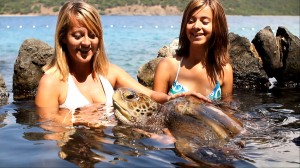
The initial small-scale tries at interaction received positive feedback and encouraged the incorporation of more opportunities, and the catalysts for even more creative experiences are based both on watching what other facilities are doing and having a knowledge of what the facilities and animals on hand will allow.
Informal staff brainstorming sessions yielded several new ideas – including interactive encounters with turtles and sharks – and, Prior said, the incremental steps tend to become more and more creative as they go.
“Sometimes it’s as simple as someone looking at turtles and knowing that people are intrigued by them, so they think, ‘Let’s find a way to get them in the water with turtles,’” she said. “Little by little, we’re finding different things and ways to get in with the animals. Sometimes it’s just a light bulb going off when someone walks by a pool. We’re getting more adventurous, little by little.”
Included in the price of park admission are the Marine Gardens, Stingray Lagoon, Shark Shallows, Undersea Observatory Tower, Touch Pool, Caribbean Reef Encounter, Shark Shallows and Turtle Pool exhibits, as well as scheduled feedings and animal presentations.
Offered in addition to admission are the Sea Lion Encounter, Sea Lion Swim, Sea Trek, SNUBA, Turtle Encounter and Shark Encounter. The latter activity includes an orientation session with a guide that’s followed by a chance to enter a pool with a variety of juvenile sharks that inhabit local waters.
Next up, according to Prior, is the $6 million, 70,000-square-foot expansion that will offer visitors a chance to interact with dolphins that were born into human care. But first, Kellar says, comes the “tremendous amount of work required” to clear the behind-the-scenes hurdles that most guests are unaware of.
The dolphin facility is expected to open in 2015. The plans were approved by the Economic Development, Agriculture and Planning Committee of the Virgin Islands Legislature.
“Some of them are more difficult than others,” Kellar said, “especially with dolphins, who are kind of lightning rods from a public image standpoint. But it’s not just the animals. There are clearly issues when you’re working around a marine environment and there are a lot of agencies out there whose mandate is to oversee any coastal development.
“Being a territory of the United States, we have the same hurdles as anyone else – the Army Corps of Engineers, the EPA, the Coast Guard – and it eventually comes down to a good, strong analytical look at the work you’re going to do and being able to determine what works and what doesn’t.”
AT A GLANCE
WHO: Coral World Ocean Park
WHAT: Open-water marine park
WHERE: St. Thomas, U.S. Virgin Islands
WEBSITE: www.CoralWorldVI.com
PREFERRED VENDORS
Quality Electric Supply. – www.qualityelectricvi.com/
Host U Services. – www.hostuservices.com/

